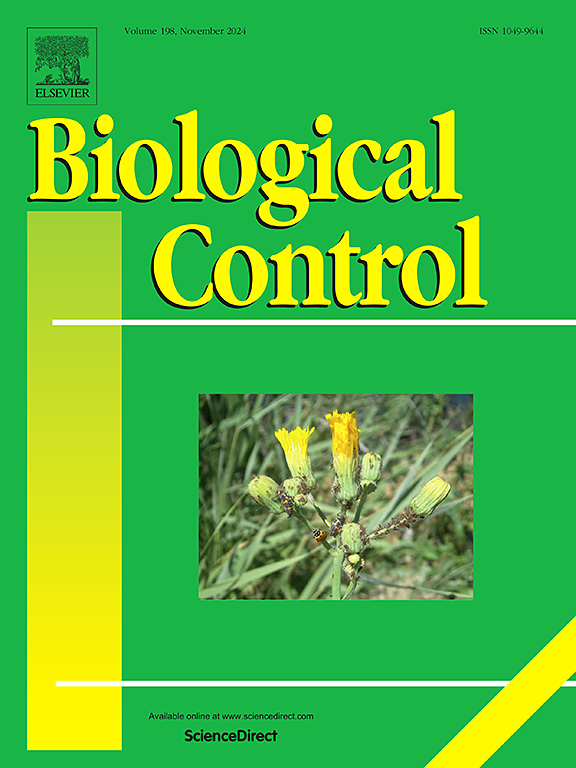拟寄生蜂幼虫与蛹的潜在相互作用及其对苏氏果蝇生物防治的意义
IF 3.4
2区 农林科学
Q2 BIOTECHNOLOGY & APPLIED MICROBIOLOGY
引用次数: 0
摘要
攻击果蝇的寄生蜂行会主要由幼虫和蛹寄生蜂组成。大多数拟寄生物幼虫是共生的,直到它们在蛹内形成蛹才杀死它们的寄主。因此,被寄生蜂幼虫寄生的寄主随后可能通过多重寄生或超寄生的方式受到寄生蜂蛹的攻击。kimorum是一种重要的寄生性幼虫,最近被引入欧洲和美国,作为一种经典的生物防治剂来防治铃木果蝇。厚皮蝇和果蝇毛蝇是两种分布广泛的寄生性蝇蛹,可能会影响金蛾的繁殖。本研究探讨了猪腹直蝇和果蝇直蝇与猪腹直蝇蝇蛹病的kimorum和黑腹直蝇蛹病的异瘤瘦蝇(Leptopilina heterotoma)的潜在相互作用。通过无选择试验和选择试验,确定了寄生蜂蛹对寄生于寄生蜂幼虫3龄幼虫的未寄生或寄生的蛹蝇的偏好,寄生蜂幼虫3龄幼虫具有寄生性,且容易被蛹蝇识别。无选择试验表明,两种寄生蜂均可寄生于已被任何一种寄生蜂寄生的蝇蛹,但只有寄生蜂成功地从多寄生的蝇蛹发育而来,雌性后代显著减少。在选择试验中,两种蛹寄生蜂对未寄生蛹的偏好高于被寄生蛹,但在后代性别比例上没有观察到差异。在体视显微镜下对多寄生的铃木木蠹蛹蝇的观察表明,铃木木蠹蛾通过对寄主的生理抑制来战胜寄生的木蠹蛾。这些发现为了解拟寄生蜂幼虫与蛹之间潜在的相互作用及其对苏氏弓形虫生物防治的启示提供了新的见解。本文章由计算机程序翻译,如有差异,请以英文原文为准。
Potential interactions of larval and pupal drosophila parasitoids and their implications for biological control of Drosophila suzukii
The parasitoid guilds attacking Drosophila spp. consist primarily of larval and pupal parasitoids. Most larval parasitoids are koinobiont and do not kill their hosts until they form pupae within puparia. Thus, a host parasitized by a larval parasitoid could be attacked subsequently by a pupal parasitoid via multi-parasitism or hyperparasitism. Ganaspis kimorum is a key larval parasitoid that has recently been introduced into Europe and the US as a classical biological control agent against Drosophila suzukii. Pachycrepoideus vindemiae and Trichopria drosophilae are two cosmopolitan pupal drosophila parasitoids that may affect the performance of G. kimorum. This study investigated potential interactions of P. vindemiae and T. drosophilae with G. kimorum in D. suzukii puparia and with Leptopilina heterotoma (a common larval parasitoid of Drosophila melanogaster) in D. melanogaster puparia. Both no-choice and choice tests were conducted to determine the pupal parasitoids’ preference to attack unparasitized or parasitized puparia containing a third instar larva of the larval parasitoid, which becomes ectoparasitic and can be easily recognized via puparium. No-choice tests demonstrated that both pupal parasitoids could parasitize puparia previously parasitized by either larval parasitoid, but only P. vindemiae successfully developed from multiparasitized puparia, with a significant reduction in female offspring. In choice tests, both pupal parasitoids preferred unparasitized over parasitized puparia, although no differences in the progeny sex-ratio were observed. Stereomicroscopic observations of multiparasitized D. suzukii puparia suggest that P. vindemiae would outcompete the ectoparasitic G. kimorum through physiological host suppression. These findings provide new insights into the potential interactions between larval and pupal drosophila parasitoids and their implications for biological control of D. suzukii.
求助全文
通过发布文献求助,成功后即可免费获取论文全文。
去求助
来源期刊

Biological Control
生物-昆虫学
CiteScore
7.40
自引率
7.10%
发文量
220
审稿时长
63 days
期刊介绍:
Biological control is an environmentally sound and effective means of reducing or mitigating pests and pest effects through the use of natural enemies. The aim of Biological Control is to promote this science and technology through publication of original research articles and reviews of research and theory. The journal devotes a section to reports on biotechnologies dealing with the elucidation and use of genes or gene products for the enhancement of biological control agents.
The journal encompasses biological control of viral, microbial, nematode, insect, mite, weed, and vertebrate pests in agriculture, aquatic, forest, natural resource, stored product, and urban environments. Biological control of arthropod pests of human and domestic animals is also included. Ecological, molecular, and biotechnological approaches to the understanding of biological control are welcome.
 求助内容:
求助内容: 应助结果提醒方式:
应助结果提醒方式:


